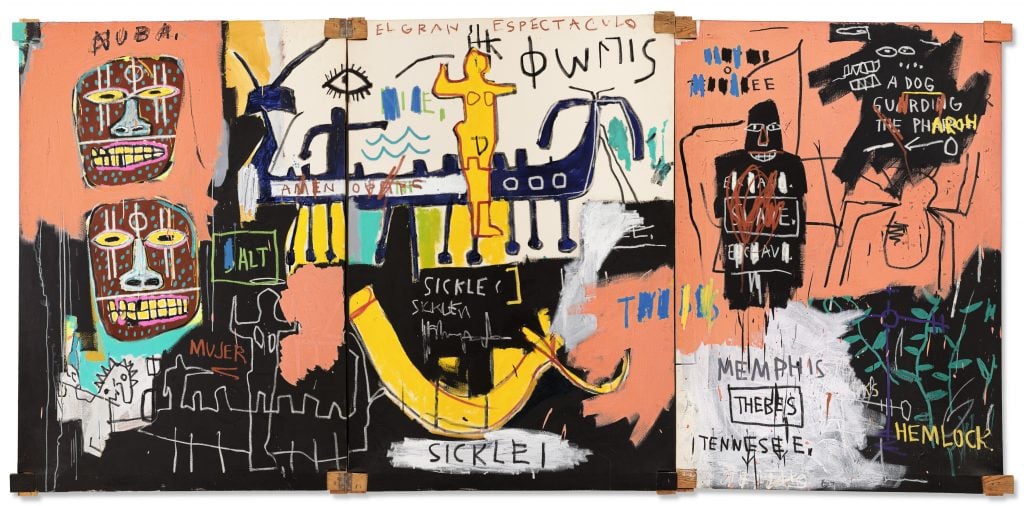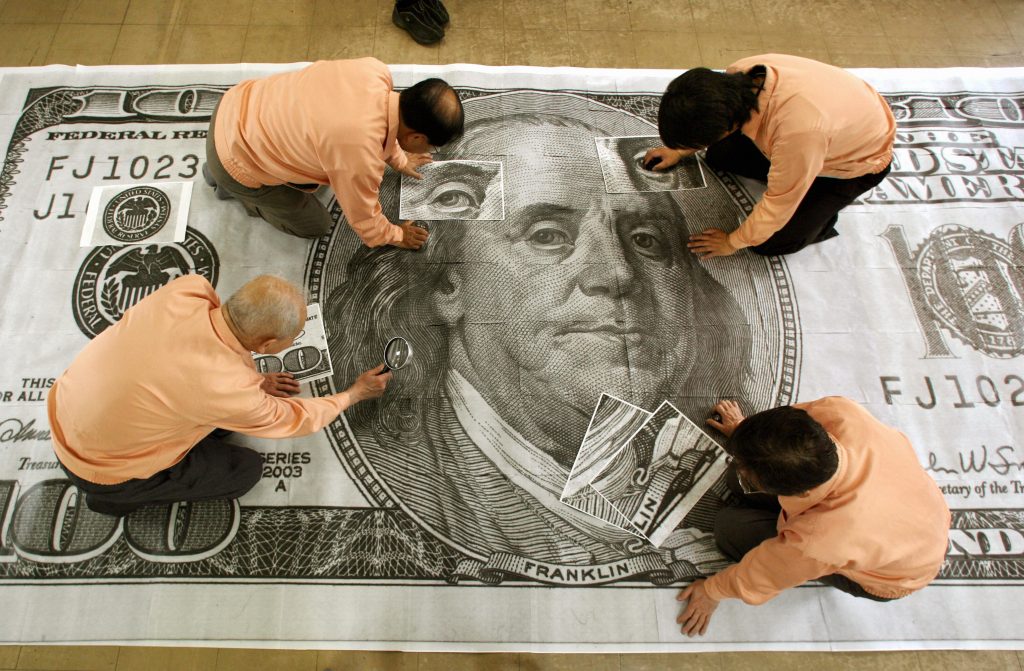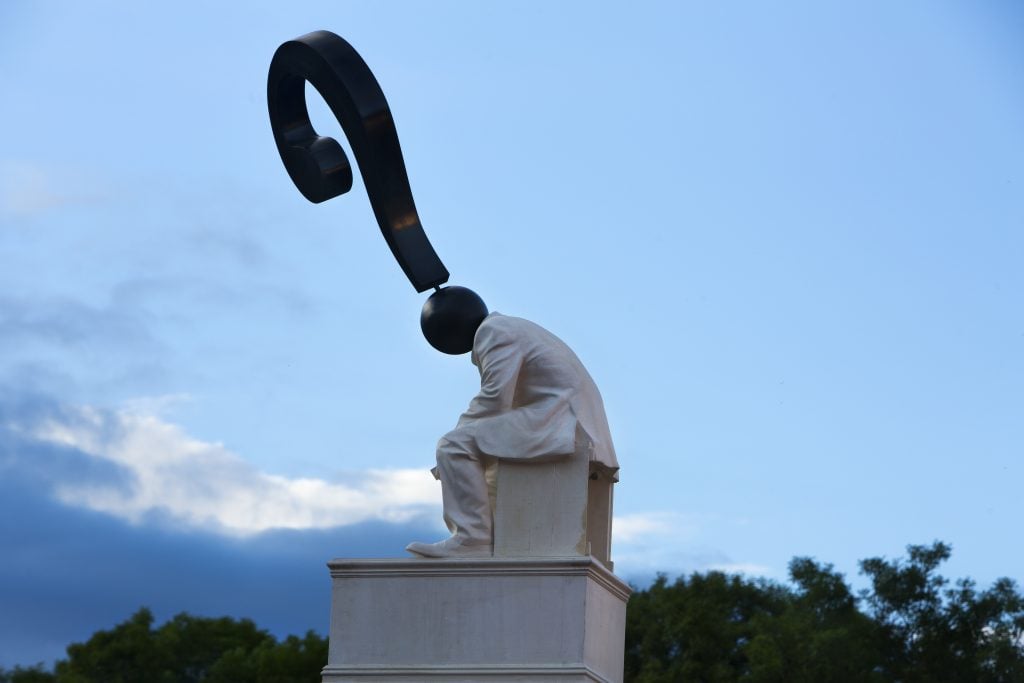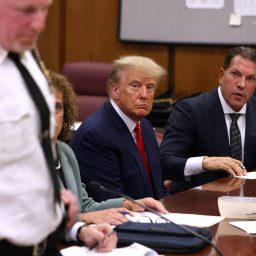Every week, Artnet News brings you The Gray Market. The column decodes important stories from the previous week—and offers unparalleled insight into the inner workings of the art industry in the process.
This week, setting the table…
Progress Report
The more things change, the more they stay the same.
As much as I hate to invoke a cliché, that one pretty well sums up the state of the art-sales business here in early May 2023. Fears of a downturn have been stalking the art market from major sales event to major sales event, global city to global city, for at least the past six months—and, by some accounts, a year or more.
And yet, even amid these choppy macroeconomic conditions, it seems that industry players are charging into the hectic next three weeks of New York art fairs, auctions, and primetime gallery openings with mentalities remarkably similar to those they exhibited a season or two ago. We can debate whether it would be more accurate to call the prevailing sentiment “cautious optimism” or “optimistic caution.” But either way, the point is the same: although the uppermost layer of froth may have fizzled out, there’s still enough effervescence in the glass to hold off the worst worries until later.
Morgan Long, the London-based managing director of the Fine Art Group, described the ongoing sense of déjà vu about whether the next major market event will kick off a downturn this way: “Every time people say, ‘Is this going to be the time?” and the market says, ‘Well, actually, no.'”
If there’s real evidence to contradict Long, I can’t find it. Dealers may not have cleaned up at the 2022 edition of Art Basel Miami Beach the way they have in true boom years, but the succeeding months have reinforced that, for the most part, business was good enough to keep the wheel turning. Multiple collectors focused on different levels of the market said that they have seen no discernible erosion in the overall mood between the first major market events of the new year and now. One Los Angeles-based advisor told me that they sold more art in the first four months of 2023 than in the last six months of 2022.
“’Recession’ was on everyone’s lips at ABMB…and thus far nothing much has materialized,” New York advisor Liz Parks emailed Monday night. “The pessimist in me wants to note that the 2008 art market recession was a slow burn, so perhaps this, too, is just several months’ worth of sparkle sprinkled on a longer slide of doom…but for the time being at least, the optimist in me is winning my internal argument.”

Anish Kapoor’s Arcelor Mittal Orbit with the world’s longest slide, by Carsten Höller. Courtesy of Arcelor Mittal Orbit.
Physical gallery expansions are still being announced at a steady clip, from Tribeca and Los Angeles, to London and Paris, to Asia and beyond. Rosters keep scaling up throughout the commercial hierarchy and across regions, too. I couldn’t tell you the last time I read a press release about a gallery closing up shop, but I could forward you several about new spaces forming.
There have also been multiple recent instances of personnel at mega-galleries decamping to launch their own spaces or join up-and-coming operations. To the former point, consider Alice Workman, previously a senior director at Hauser and Wirth, co-founding the British gallery Bo Lee and Workman this spring. To the latter, see former David Zwirner head of events L.A. Vandyke opting out for a director role at Amanita gallery in April, and Hauser and Wirth associate director Jed Moch joining Company gallery as a director in March. These are not moves that one tends to make in a particularly scary part of the business cycle.
Subtler but no less important an indicator of the market’s health is that, when it comes to hiring, it’s an applicant’s market.
“In London at least, good support staff are hard to get: people keep asking me if I know a good registrar, a good sales associate,” Long said. “That’s not what happens when things are bad. That’s a sign that business is happening.”
What about the fairs? Every major expo slated for May and June, including the upcoming editions of Frieze New York, Independent, TEFAF New York, and Art Basel, is returning with more exhibitors than its 2022 iteration. Three fairs shuttered for good in London in this year’s first two months (Masterpiece London, as well as the smaller Open Art Fair and Art and Antiques Fair Olympia), but at least as many new events have cropped up to replenish the ranks, including the Treasure House Fair in London, Korean Art London, and the stateside Dallas Invitational.
As for this month’s auctions, the consensus review of Christie’s and Sotheby’s upcoming offerings is that they’re generally strong and crowd-pleasing, despite lacking the sort of crown jewels of the collections of Paul Allen and other big-name, recently deceased patrons whose wares were auctioned last May and November. No obvious frailties emerged from the most recent London and Hong Kong sales, which performed well enough to push off the shadow of a long-awaited downturn.

Jean-Michel Basquiat, El Gran Espectaculo (The Nile) (1983). Estimate on request; in the region of $45 million. Courtesy Christie’s Images Ltd 2023.
At a glance, the atmosphere and the activity defy the headlines about the economy. Over the weekend, federal regulators seized struggling First Republic Bank and swiftly sold it off to JPMorgan Chase at a bargain price. First Republic is now the third regional U.S. bank to go down for the count this year, after Silicon Valley Bank and Signature Bank. (Credit Suisse, acquired by longtime rival UBS on the orders of Swiss officials in March, imploded due to a largely separate set of issues.)
Just as important, one of the main culprits behind these bank failures is still running amok and may get even more aggressive soon. The Federal Reserve was set to announce shortly after this column’s publication on Wednesday whether it would continue its yearlong effort to flatten inflation by raising interest rates yet again. If the central bank does opt for that approach, as most analysts expect it to, its benchmark rate would top five percent for the first time since 2007—a disorienting reversal from March 2022, when rates hovered near zero.
Banking turmoil, rate hikes, and inflation are cooling dealmaking outside the art world, too. Ken Jacobs, chairman and CEO of the 175-year-old investment bank Lazard, said on a recent earnings call that mergers-and-acquisitions activity had not been this subdued since 2012, according to William Cohan of Puck. The IPO market continued to slide, too: the number of companies to go public in the first quarter of 2023 was down 8 percent year over year, while the total cash they raised was down an unsettling 61 percent year over year, per Ernst and Young.
It’s not all bad news, though. After a series of dives and rallies, all three major U.S. stock market indexes were up year-to-date as of Tuesday afternoon. The tech-centric Nasdaq was leading the pack with a 16.3 percent gain in 2023, followed by the S&P 500 with a 7.7 percent gain, and the Dow Jones with a 1.6 percent gain.
It’s too early to tell whether the investing class at large agrees with JPMorgan Chase CEO Jamie Dimon, who declared after his mega-bank scooped up First Republic that “this part of the crisis is over.” But at the moment, the big, broad arrows are pointing in the right direction. What’s more, an unassailable source in Silicon Valley told me this week that top venture capitalists are quietly strategizing for IPOs in the fourth quarter.
Back to the art side of the ledger: My sense is that the cautious optimism/optimistic caution about the spring cycle is also justified by longer-running structural factors at play within our niche business. While the art market is still small in the grand scope of other industries, there’s no denying that the past 10 to 15 years have seen a significant expansion in the buyer base. We can argue all day about what percentage of the gain is made up of pure speculators versus emotionally invested collectors—as if there were a brick wall, not a long and nuanced continuum, separating the two categories—but what matters most is that business is business, and competition is competition.

Craftworkers compare blown-up sections of counterfeit hundred-dollar bills with a sample legitimate bill expanded to 400x actual size. Photo: KAZUHIRO NOGI/AFP via Getty Images.
Whether the primary motivator is a juicy return, social capital, or a quasi-religious pursuit of aesthetic transcendence, more wealthy people than ever are in the arena for establishment-approved artworks. The relative size of the buying audience will always be larger during clear market upswings, but the absolute size of the buying audience in the 2020s dwarfs its equivalent at a similar point in the business cycle a generation ago. Case in point: the number of global millionaires had already risen to 62.5 million in 2021 and is projected to grow another 40 percent, to 87.5 million, by 2026 per a Credit Suisse global wealth report released last September.
One consequence of this shift may be that the price floor at nearly every tier of the market has been raised for good. Even when market conditions suggest that the optimal move is to hunt bargains, there will be more opportunists pursuing those bargains than there used to be… which means that the bargains simply aren’t likely to get as cruel and offensive to the seller (and thus, as lucrative for the buyer) as they used to. Competition works the same on the way down as it does on the way up, it turns out—barring a genuine macroeconomic meltdown, that is.
None of this is to say that art sales have developed immunity to any and all problems plaguing the larger worlds of business and economics. Investors still appear to be wary of vulnerabilities in smaller American banks. The U.S.’s two major political parties are once again playing a high-stakes game of chicken over the country’s debt ceiling, raising the prospect that the nation could default on its obligations to creditors by June 1 and upend the global financial picture in the process. Growing fears of that possibility, or any other unforeseen blow to the stock market, could still hurt the New York auction business to a unique degree.
“One thing we’ve always noticed in the U.K. and elsewhere is that collectors watch the stock market a little bit less,” Long of the Fine Art Group said. “That’s a really New York phenomenon. If for some reason the markets drop in a big way not next week but the week after, it could affect things.”
Yet this too is just another “could.” Just because reasonable professionals can imagine something finally knocking the art world off its axis doesn’t make it any more likely to happen than last winter, or last fall, or last summer, or last spring—or whenever it was that you, personally, first heard someone you trust hedge on how much longer the good times (or at least the good-enough times) would keep rolling. Based on the evidence I’ve seen and the dynamics of this strange market we’ve created, the truly stunning question to mull at this point isn’t “When will the other shoe drop?” It’s “What if the worst of what we’ve been bracing for is already over?”
“Galleries and auction houses have great work to sell, collectors are acquiring it, shippers are shipping, installers are installing,” Parks said. “The NYC art market is a well-oiled machine, ready for its seasonal close-up. What’s the line from Rent: ‘No day but today’? Perhaps all of this will be short-lived, but for the time being, I will take it.”
That’s all for this week. ‘Til next time, remember what Chris Rock said: What goes around doesn’t always come around; sometimes, it just keeps going.
Follow Artnet News on Facebook:
Want to stay ahead of the art world? Subscribe to our newsletter to get the breaking news, eye-opening interviews, and incisive critical takes that drive the conversation forward.











